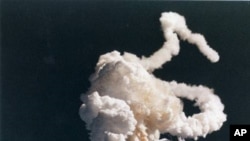Each January, the U.S. space agency NASA holds a Day of Remembrance to honor those who have lost their lives in the pursuit of space exploration. It also marks 25 years since the loss of the space shuttle Challenger, which stunned the nation and changed America's space program.
Challenger blasted off into clear blue skies on January 28, 1986. And then, 73 seconds later, the unthinkable.
VOA's Greg Flakus was there. He says the liftoff looked flawless. "And then I saw the split there where the two rockets kind of veered off with a lot of smoke and we saw debris falling, and I'd never seen that before. I'd watched several launches, but I'd never seen it, and I thought, 'Well, maybe because it's such a clear day, I'm seeing this in a little different way than I normally would have.' But then we heard the NASA announcer, one of the public affairs officers, say, 'Obviously, a major malfunction' and those words had a big impact. It hit you right in the gut," he said.
The loss of the seven-member crew left Americans and their president in grief. "We will never forget them, nor the last time we saw them, this morning, as they prepared for the journey and waved goodbye and 'slipped the surly bonds of earth' to 'touch the face of God,'" President Reagan said.
Among the astronauts was an ordinary citizen, Christa McAuliffe, picked to be the first school teacher in space. School children across the country watched the disaster unfold.
Valerie Neal is curator of the human spaceflight collection at the Smithsonian National Air and Space Museum in Washington. She says that by the mid-1980s, the public thought launches were ordinary. "The shuttle had flown 24 times without any major, show-stopping events. It had begun to seem routine. People weren't paying much attention anymore. Spaceflight is always experimental. It is always high risk," she said.
Immediately after Challenger, NASA established a new safety office and took other steps, as well. "The first and most important one, I think, was the redesign of the solid rocket booster joints, so that that particular technical cause of the tragedy could not happen again," she said.
Challenger was not NASA's first tragedy, nor the last.
On January 27, 1967, the three astronauts of the Apollo 1 mission died in a flash fire on the launch pad.
On February 1, 2003, the space shuttle Columbia disintegrated minutes before landing, killing the seven astronauts on board.
Given all the tragic losses, Neal says she is struck by the resilience of the space program. "You hate to say that tragedy is the price of exploration, but it is sometimes the consequence of exploration. The fact, though, that the space shuttle program didn't close down, that we didn't close up shop and say, 'This is too dangerous. We're not going to do it anymore,' I think, is a tribute to the American people and the American spirit," she said.
The next shuttle launch is set for late February. Discovery's blastoff has been postponed several times over several months for reassessments and repairs.
Space Shuttle Challenger Loss Still Felt, 25 Years Later












